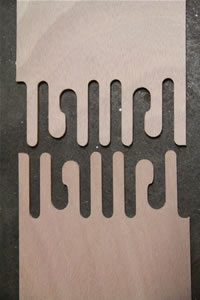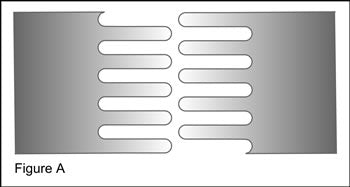Joining the Hull Panels
About Our SnapTite Joint System
 For boats longer than eight feet, it is usually necessary to join two or more pieces to create each of the long panels the hull is comprised of. There are several ways of doing this including using butt joints (butting two flat edges together and reinforcing with fiberglass and resin or a piece of wood) or scarf joints (cutting acute angles in the plywood surface to increase the surface area for gluing).
For boats longer than eight feet, it is usually necessary to join two or more pieces to create each of the long panels the hull is comprised of. There are several ways of doing this including using butt joints (butting two flat edges together and reinforcing with fiberglass and resin or a piece of wood) or scarf joints (cutting acute angles in the plywood surface to increase the surface area for gluing).Kits cut by a CNC cutter are able utilize a simpler and more elegant solution: interlocking fingers, a technique made possible by the accuracy of robotic cutting. This is the method we use in our boat kits. There is a great range of interlocking finger designs used in the kit-boat market, and they are not all created equally. When considering kit boats, look closely at the engineering and precision behind the finger joints, as this often reflects the overall design and quality of the boat.
There are four main objectives we are trying to achieve with our panel jointing system:
Strength: It is imperative that the design is as strong as possible, bringing the strength of the joint to that of the adjacent plywood. This is the primary purpose of the joint.
Self Alignment: When multiple pieces are joined together, correct alignment is necessary so the curves of the completed panel are correct. Non-aligning joints (such as a scarf joint or sloppy finger joints) need to be measured up from a string line to ensure that the pieces are oriented correctly while the glue/epoxy cures. This creates additional work and complexity for the builder. Finger joints can be self-aligning, but only with the right design and precise cutting.
Ease for the Builder: Every step in boatbuilding from a kit should be as efficient and
straightforward as possible. Creating unnecessary or extraneous work is simply bad design. Joining hull panels properly can be a process that takes several minutes or several hours.
Aesthetics: For boats with a clear finish, every blemish in craftsmanship shows through. A perfectly designed and fitted joint is important for a good looking boat.
About our Finger Jointing System
After months of calculations, experimentation and brainstorming we came up with a system that is up for the job. Our SnapTite jointing system achieves the key elements of a good joint as described below.
Strength
 There are many factors that contribute to the strength of an interlocking finger joint. To understand the basis of how interlocking fingers work, let’s first imagine the opposite of what we’re trying to achieve; creating a poor joint by simply gluing the straight ends of two pieces of plywood together. As you can easily envision, this join would be incredibly weak, and would probably break when you picked up one end of the plywood. The reason is because there is very little surface area being glued proportionate to the amount of stress being transferred through the panels.
There are many factors that contribute to the strength of an interlocking finger joint. To understand the basis of how interlocking fingers work, let’s first imagine the opposite of what we’re trying to achieve; creating a poor joint by simply gluing the straight ends of two pieces of plywood together. As you can easily envision, this join would be incredibly weak, and would probably break when you picked up one end of the plywood. The reason is because there is very little surface area being glued proportionate to the amount of stress being transferred through the panels.
By cutting a zigzagging shape we are increasing the amount of surface area being glued relative to the stresses being transferred through the wood. The narrower and longer we create the “fingers” the more we increase the glue surface area per inch across the panel, and the stronger the joint becomes. There is a practical limit to how long and narrow you can make the fingers due to their increased vulnerability in shipping and the size of cutter bits, so the key is to make the fingers narrow and long enough to offer sufficient strength while still being practical.
Self Alignment
 Straight edged fingers offer the greatest strength in a finger joint (see figure A), however, they don’t offer the best self aligning characteristics. While gluing, it is possible for the fingers to slip out from one another and for the pieces to stray from perfect alignment (see figure B). A solution for this problem is to use “puzzle” joints instead of straight fingers (see figure C) which ensures proper alignment. This, however, introduces a new problem from an engineering perspective.
Straight edged fingers offer the greatest strength in a finger joint (see figure A), however, they don’t offer the best self aligning characteristics. While gluing, it is possible for the fingers to slip out from one another and for the pieces to stray from perfect alignment (see figure B). A solution for this problem is to use “puzzle” joints instead of straight fingers (see figure C) which ensures proper alignment. This, however, introduces a new problem from an engineering perspective.
 “Puzzle” joints reduce the ability of the wood to convey tensile forces transferred along its length. To envision this concept look at figure D which illustrates an exaggerated puzzle joint. As you can see, the benefit of having increased glue surface area is lost, because of the minimal intact wood remaining to transfer the strength of these bonds to the rest of the panel. In short, having "puzzle” jointing fingers instead of straight fingers reduces the strength of the joint to an unacceptable level. This problem can be resolved by adding applying a layer of glass tape and epoxy for reinforcing, but this adds to the complexity, time and weight. Our goal is to have the finger joints alone providing sufficient strength to connect the panels without need for further reinforcing.
“Puzzle” joints reduce the ability of the wood to convey tensile forces transferred along its length. To envision this concept look at figure D which illustrates an exaggerated puzzle joint. As you can see, the benefit of having increased glue surface area is lost, because of the minimal intact wood remaining to transfer the strength of these bonds to the rest of the panel. In short, having "puzzle” jointing fingers instead of straight fingers reduces the strength of the joint to an unacceptable level. This problem can be resolved by adding applying a layer of glass tape and epoxy for reinforcing, but this adds to the complexity, time and weight. Our goal is to have the finger joints alone providing sufficient strength to connect the panels without need for further reinforcing.
Our solution is to use straight fingers through most of our joint for strength combined with just one “puzzle” finger on each end to ensure perfect alignment (see Figure E). Upon testing, such an arrangement worked perfectly, offering optimal strength so no additional reinforcing is required, along with impeccable alignment.
Ease for Builder
 We incorporate a 0.005” slip gap between the mating fingers so no sanding or other work is required for a perfect snug fit. Joining the panels together is a breeze taking just a few minutes. Simply brush epoxy onto the mating surfaces, press them together with and allow the epoxy to set. As soon as the epoxy cures, the hull is ready to be assembled. Pure simplicity!
We incorporate a 0.005” slip gap between the mating fingers so no sanding or other work is required for a perfect snug fit. Joining the panels together is a breeze taking just a few minutes. Simply brush epoxy onto the mating surfaces, press them together with and allow the epoxy to set. As soon as the epoxy cures, the hull is ready to be assembled. Pure simplicity!Aesthetics
The interlocking fingers mesh so perfectly you may want to show off in the finished boat. Just as woodworkers are proud to display an impeccable dovetail joint, your SnapTiteTM joints will convey the quality and precision than went into creating your vessel.
Final Design Modifications
 After designing an effective finger jointing system, we further refined the shapes to offer additional benefits. We created an asymmetrical design, so it is impossible to join the pieces the upside down. We also modified the shape of each joint, so only the correct panels can be jointed to one another, reducing the risk of disastrous mistakes. And finally, we scale each shape perfectly to the width of the panel. A standard template shape that gets cut randomly depending on the width of the panel leaves partial fingers at the edges which are vulnerable in shipping and construction.
After designing an effective finger jointing system, we further refined the shapes to offer additional benefits. We created an asymmetrical design, so it is impossible to join the pieces the upside down. We also modified the shape of each joint, so only the correct panels can be jointed to one another, reducing the risk of disastrous mistakes. And finally, we scale each shape perfectly to the width of the panel. A standard template shape that gets cut randomly depending on the width of the panel leaves partial fingers at the edges which are vulnerable in shipping and construction.We spent a lot of time developing and trialling our boat designs, and wanted to make sure our jointing system is in line with the rest of the boat. We’re pretty confident you’ll like our SnapTiteTM jointing system as much as the boat.
